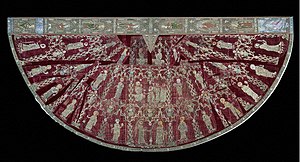
The Butler-Bowdon Cope (or Butler-Bowden) is a cope in the collection of the Victoria and Albert Museum. It derives its name from the family who owned it for several centuries. It dates from 1330 to 1350 and shows scenes from the Life of the Virgin with Apostles and saints, embroidered with silver, silver-gilt thread and silk, on a rich crimson velvet. This was the ideal base for the high quality English embroidery (called Opus Anglicanum, the Latin for "English work") which was much coveted by the most powerful people in Europe including kings and popes, and was used as a forceful visual statement of their wealth and status.
Many medieval church vestments were later cut up and re-used. This cope, as can be seen from its dismembered state, was made into a variety of ecclesiastical garments, but was re-assembled in the 19th century.
References
- ^ "Butler-Bowdon Cope". V&A Collections. Victoria & Albert Museum. Retrieved 7 October 2024.
| Embroidery | ||
|---|---|---|
| Styles |    | |
| Stitches | ||
| Tools and materials | ||
| Regionaland historical | ||
| Embroideries |
| |
| Designersand embroiderers |
| |
| Organizationsand museums | ||
| Related | ||
This Christianity-related article is a stub. You can help Misplaced Pages by expanding it. |
This clothing-related article is a stub. You can help Misplaced Pages by expanding it. |
This textile arts article is a stub. You can help Misplaced Pages by expanding it. |